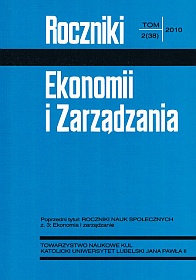Opcje egzotyczne – wybrane przykłady opcji drugiej generacji
Abstrakt
An option is one of the derivative instruments giving the right to buy or sell a specific amount of an underlying asset at an agreed price on or before a specified date in the future. With the option market growth and with the growing sophistication of investors, in addition to the standard (plain vanilla) calls and puts, the new products have arisen, called exotic options. These instruments, also known as the second generation options, can be defined as the option contracts with the payoff structure different from the standard European and American options.
The aim of the paper is to make a synthetic presentation of the large family of exotic options. With reference to the characteristics defined by M. Ong, six groups of exotic options are identified and described on the selected examples, namely:
– singular payoff options – options characterized by discontinuities or sudden jumps in the payoff function,
– time-dependent options – options giving the right to choose the exercise date or certain features in the future,
– nonlinear payoff options – options with nonlinear relation between income and price of the underlying instrument,
– compound options – options for which the underlying is another option,
– correlation options – options which are dependent on two or more underlying assets,
– path-dependent options – options contingent on the price path taken by the underlying asset.
Bibliografia
Aparicio S. D., Clewlow L., American featured options, w: Exotic Options. The State of the Art, red. L. Clewlow, Ch. Strickland, International Thomson Business Press, London, Boston 1997.
Gudaszewski W., Łukojć A., Mróz W., Wycena jednoczynnikowych opcji egzotycznych, „Rynek Terminowy”, 2004, nr 1, s. 13-23.
Hull J.-C., Options, Futures and Other Derivatives, Prentice Hall, New Jersey 2002.
Jajuga K., Gudaszewski W., Mróz W., Opcje egzotyczne – wprowadzenie, „Rynek Terminowy”, 2004, nr 1, s. 6-12.
Krawiec M., Zastosowania instrumentów pochodnych do ograniczania ryzyka rynkowego, Wydawnictwo SGGW, Warszawa 2007.
Kuźmierkiewicz M., Ewolucja rynku opcji ku pozagiełdowym opcjom egzotycznym iich klasyfikacja, „Bank i Kredyt”, 1999, nr 3, s. 15-20.
Kuźmierkiewicz M., Ogólna charakterystyka opcji egzotycznych, „Bank i Kredyt”, 1999, nr4, s. 19-29.
Kuźmierkiewicz M., Opcje korelacyjne, „Bank i Kredyt”, 1999, nr 5, s.25-34.
Kuźmierkiewicz M., Opcje uwarunkowane, „Bank i Kredyt”, 1999, nr6, s. 17-32.
Napiórkowski A., Charakterystyka, wycena i zastosowanie wybranych opcji egzotycznych, Narodowy Bank Polski, Warszawa 2002.
Ong M., Exotic Options: The Market and Their Taxonomy, w: The Handbook of Exotic Options. Instruments, Analysis, Applications, red. Nelken I., McGraw-Hill, New York 1996.
Pruchnicka-Grabias I., Egzotyczne opcje finansowe, Systematyka, strategie, wycena, CeDeWu, Warszawa 2009.
Smithson Ch. W., Smith, Jr. C. W., Wilford D. S., Zarządzanie ryzykiem finansowym. Instrumenty pochodne, inżynieria finansowa i maksymalizacja wartości, przeł.G. Łuczkiewicz, J.Katolik, Oficyna Ekonomiczna, Kraków 2000.
Taylor F., Rynki i opcje walutowe, przeł. Raczyński M., Oficyna Ekonomiczna, Kraków 2000.
Weron A., Weron R., Inżynieria finansowa. Wycena instrumentów pochodnych. Symulacje komputerowe. Statystyka rynku, Wydawnictwo Naukowo-Techniczne, Warszawa 1998.
Zhang P. G., Exotic Options: a Guide to Second Generation Options, World Scientific Publishing, Singapore 1998.
Copyright (c) 2010 Roczniki Ekonomii i Zarządzania

Utwór dostępny jest na licencji Creative Commons Uznanie autorstwa – Użycie niekomercyjne – Bez utworów zależnych 4.0 Międzynarodowe.


